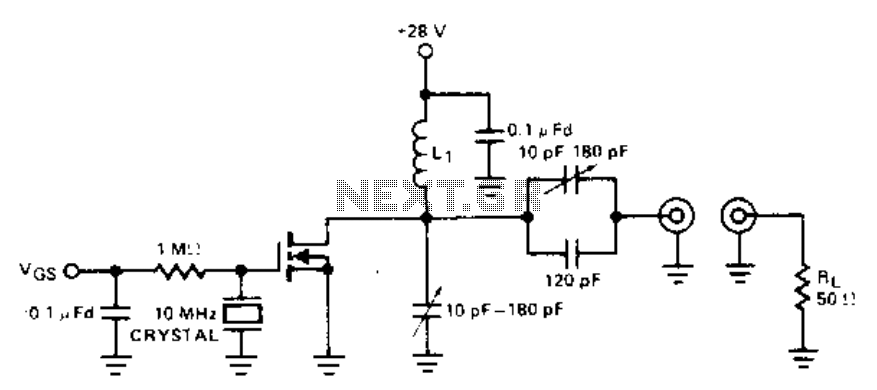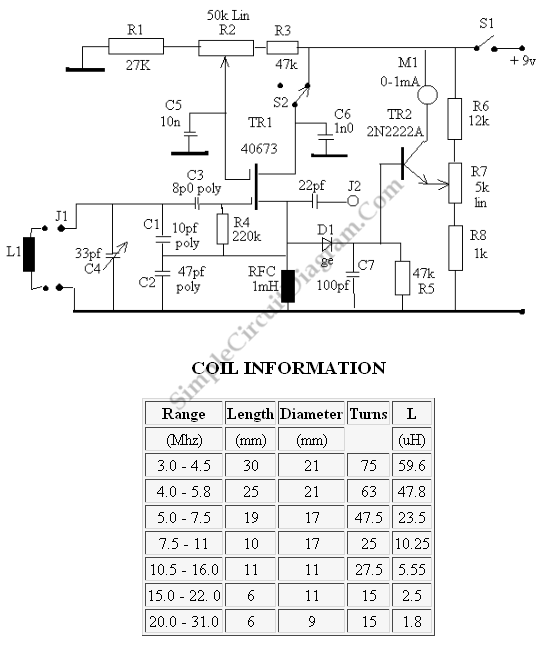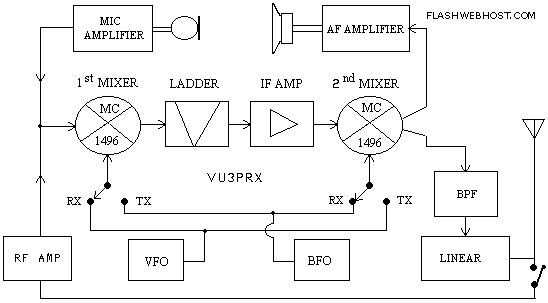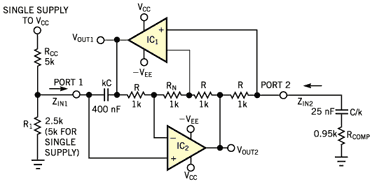
10 Mhz crystal oscillator

This crystal oscillator is a FET equivalent of a vacuum tube tuned to a plate-tuned grid crystal oscillator. Feedback is achieved through the drain to gate capacitance.
The described crystal oscillator utilizes a Field Effect Transistor (FET) to replicate the functionality of a traditional vacuum tube oscillator, specifically one that employs a plate-tuned grid configuration. The FET serves as an active device, providing the necessary gain and oscillation characteristics while benefiting from the solid-state advantages of lower power consumption and increased reliability.
The oscillator's feedback mechanism is established through the capacitance between the drain and gate of the FET. This configuration allows for a stable oscillation frequency determined by the crystal's characteristics and the reactive components in the circuit. The feedback loop is critical for sustaining oscillations and ensuring stability in the output waveform.
The parts list specifies the use of an inductor (Li), which is constructed using approximately 18 turns of 22 AWG enameled wire wound on a Micrometals T-50-6 toroidal core. This core material is chosen for its low loss and high magnetic permeability, which enhances the inductor's efficiency. The inductance value is approximately 1.0 µH, which, in conjunction with the crystal and other passive components, will define the operational frequency of the oscillator.
The overall design of this oscillator circuit is suitable for applications requiring precise frequency generation, such as in RF signal generation, clock generation for digital circuits, or as part of a more complex modulation scheme. Proper layout and component selection are essential to minimize parasitic capacitances and inductances that could affect the oscillator's performance.This xtal oscillator is a FET equivalent of a vacuum tube tuned to plate-tuned grid xtal oscillator. Feedback is via the drain to gate capacitance. Parts List: Li ~ 18 turns *22 enameled wire on micrometals, T-50-6 torroid core. = 1.0 µ. 🔗 External reference
The described crystal oscillator utilizes a Field Effect Transistor (FET) to replicate the functionality of a traditional vacuum tube oscillator, specifically one that employs a plate-tuned grid configuration. The FET serves as an active device, providing the necessary gain and oscillation characteristics while benefiting from the solid-state advantages of lower power consumption and increased reliability.
The oscillator's feedback mechanism is established through the capacitance between the drain and gate of the FET. This configuration allows for a stable oscillation frequency determined by the crystal's characteristics and the reactive components in the circuit. The feedback loop is critical for sustaining oscillations and ensuring stability in the output waveform.
The parts list specifies the use of an inductor (Li), which is constructed using approximately 18 turns of 22 AWG enameled wire wound on a Micrometals T-50-6 toroidal core. This core material is chosen for its low loss and high magnetic permeability, which enhances the inductor's efficiency. The inductance value is approximately 1.0 µH, which, in conjunction with the crystal and other passive components, will define the operational frequency of the oscillator.
The overall design of this oscillator circuit is suitable for applications requiring precise frequency generation, such as in RF signal generation, clock generation for digital circuits, or as part of a more complex modulation scheme. Proper layout and component selection are essential to minimize parasitic capacitances and inductances that could affect the oscillator's performance.This xtal oscillator is a FET equivalent of a vacuum tube tuned to plate-tuned grid xtal oscillator. Feedback is via the drain to gate capacitance. Parts List: Li ~ 18 turns *22 enameled wire on micrometals, T-50-6 torroid core. = 1.0 µ. 🔗 External reference





